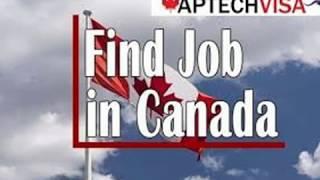It can be difficult to figure out how to apply for employment in Canada, but if you are familiar with the process, it will be simple. Thousands of people from all around the world are seeking for jobs in Canada. Before you may get the job, the Canadian employer must agree to sponsor your working visa so that you can migrate from your home country. We’ll get right to it and explore how to get a work visa in Canada.
Canada Work Permit
A work visa is another term for a Canadian work permit, which allows qualifying foreign applicants to work in Canada for a set period of time. When you get a job offer from a Canadian employer, it is the best moment to apply for a Canadian work permit. On the other hand, the employer will seek a Labour Market Impact Assessment from Employment and Social Development Canada in order to hire you.
Canada is one of the most prosperous countries in the world, and it has a proven track record that has attracted foreign workers. The Canadian work permit is quite important. Permanent workers, business persons, international students, and temporary workers are all allowed to work in Canada without being harassed by immigration agents. It’s a good idea to get a job in Canada to improve your chances of getting a work permit.
Benefits of Canada Work Permit
In 2021, the Canadian government granted a work permit to over 400,000 applicants. The Canada work permit offers you lots of opportunities:
- Work under any Canadian employer
- Get paid in dollars
- Increase your chance to have a dependent visa
- Travel across different parts of Canada
- Applying for a permanent residence visa
Canada Work Permit Application
A worker will require a job offer letter, contract, a copy of the LMIA, and the LMIA number to apply for a work permit. One of the first steps in looking for jobs in Canada is to obtain a work visa. Employers in Canada must apply for a Labour Market Impact Assessment for their workers. In other words, you receive a copy of the LMIA from your company as a worker.
The major objective for applying for this LMIA is to ensure that the empty posts are filled by Canadian citizens. To work in these positions, you will require a copy of the LMIA as well as the LMIA number. In the long run, if you want to work for another company, they must first obtain a Labour Market Impact Assessment to ensure that there is no indigene to fill the position before hiring you.
What are the Eligible Requirements for Work Permit?
A valid work permit is required for the majority of jobs in Canada. These are the requirements that must be fulfilled in addition to your steps in applying for a job in Canada:
- Proof you will leave the country after the expiration of your Canadian work permit.
- Proof of financial statement to after for your need throughout your stay in Canada.
- Proof you have no history of criminal record or criminal record.
- Proof you have a good medical history and you are free from illnesses or diseases.
- Willingness to obey the rules and regulations of your Canada work permit.
- Meet requirements like language skills, insurance, biometric data, etc.
- Valid identification passport of more than 6 months
- Two recent passport photographs
- Educational qualification degrees/certificates
- Work experience
- Application fee for processing
Labour Market Impact Assessment
It is a document that Canadian firms use to engage a foreign worker when they are unable to find a Canadian citizen to fill the position. Various Canadian businesses in fields such as agriculture, academia, caregiving, and Quebec province have requested this Labour Market Impact Assessment for their foreign workers.
Application Requirements for Labour Market Impact Assessment
To apply for a work permit through LMIA, an employer needs to do the following before they can employ a foreign worker:
Processing Fee:
You must pay a CAD 1,000 application fee. If the outcome is negative, the money is not refundable. Certain applicants, such as in-home caregivers, are exempt from paying the cost under the Labour Market Impact Assessment.
Business Legitimacy Documents:
Your status must demonstrate that you are conducting a genuine Canadian business.
Transition Plan:
There must be a strategy in place for how the Canadian firm will deal with the foreign nationals they wish to hire.
Recruitment Efforts:
Employers in Canada must demonstrate that they have made significant efforts but have been unable to find a Canadian employer to fill the post.
- Wages:
The TFW pay must be included in the application to help distinguish between low-wage and high-wage positions and to guarantee that TFWs are paid on par with their Canadian counterparts.
Workplace Safety:
TFWs have the same right to health and safety in the workplace as other Canadian employers in similar positions. As a result, employers will have to show proof that TFWs would be protected by insurance that is comparable to that of the province in Canada.
What Is the International Mobility Program (IMP)?
Employers in Canada can use the International Mobility Program to hire international workers to work alongside them. The IMP is another option for finding Canadian employers, and it is a much faster process than the LMIA.
Employers who are interested in your skill set must make a job offer through the Employer Portal. You’ll also include the number of your job offer in your work permit application. Some occupations may not necessitate a Labour Market Impact Assessment. The nature of the employment determines whether the work permit is open or closed, and if it is LMIA-exempt. Some of these occupations include:
- Self-employed individuals
- Tech professionals
- Academic researcher
- Experience healthcare workers
- French-speaking skilled workers
- Professional athletes, etc.
Searching for Canadian Jobs
A resume is a necessary tool for obtaining jobs and obtaining interviews. Their resumes are formatted conventionally in Canada. Instead than reading a long list of positions on resumes, Canadian employers prefer to read highlights of work experience. Rather than utilizing a generic resume for every application you see online or offline, each resume you create should be tailored to the employment opportunity you are applying for.
Furthermore, due of its success in the Canadian work market, you might include a cover letter with your resume. If you can write an excellent cover letter, you can entice a potential employer to hire you. When looking for a job in Canada, it’s critical to keep your curriculum vitae up to date because it’ll be the first thing an employer sees before they interview you. If you’re unsure how to improve your CV, consider the following suggestions:
- Be Truthful with every piece of information on the CV
- Write a clear contact address for your home and email address
- Use a clear layout including headlines like personal data, education, experience, skills, contact information, references, etc.
- No lengthy pages because you can use 2 pages for your CV
- Pick a professional CV design that will match the nature of the job
- Update with most recent work experience
- Research about the company or employer
- Double-check the information for errors
Applying for a job in Canada
You can apply these five steps to secure a job in Canada:
- Updating your Resume or Curriculum Vitae:
The resume should contain simple and well-detailed at the same time with certain information such as education, employment history, achievements, education, experience, contact information, etc.
2. Cover Letter and Resume:
You should explain why you need the job in your cover letter. The hiring manager will ask for further information about your skillset to see if they match the requirements of the position. Furthermore, the most important thing you can provide the organization is long-term growth
3. Research:
You’ll need to do some extra research on the organization to learn more about its services, mission, and vision statement. The easiest approach to learn about this is to go to their website and look at their business culture. If they have any job openings, you will be able to learn about them on their website.
4. Social Media:
In order to find jobs in Canada, you can use social media platforms such as Instagram, Twitter, Facebook, and LinkedIn. Because the company will want to interview you to see if you are competent, it is best if you are skilled or experienced in your profession
5. References:
If you include references, the Canadian employer will gain a better understanding of your personality. It is an effective method of obtaining employment. You can request references from previous or previous employers in your country of residency.
6.Follow Up:
In a competitive market, following up on your application will differentiate you from others. After submitting your resume, and interview, you can send the hiring manager a thank you note to show a sign of appreciation for them.
Conclusion:
Getting a job in Canada necessitates some work on your part and on the part of the Canadian employer. If you’ve ever been perplexed, read this article and apply the advice to make things easy for yourself. Take action and apply for employment in Canada by following these steps.








